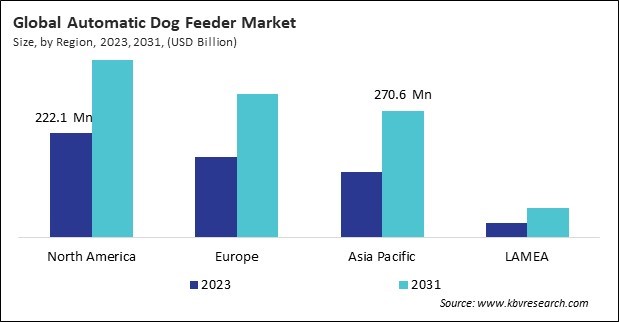According to a new report, published by KBV research, The Global Automatic Dog Feeder Market size is expected to reach $1 billion by 2031, rising at a market growth of 7.8% CAGR during the forecast period. In the year 2023, the market attained a volume of 11,031.01 thousand units experiencing a growth of 20.7% (2020-2023).
The Programmable Dog Feeder segment is registering a CAGR of 7.5 % during the forecast period. Programmable feeders often have additional smart features like app control, voice recording, and Wi-Fi connectivity. These features enable pet owners to monitor and adjust feeding schedules remotely, providing peace of mind and greater flexibility.

The Traditional Dog Feeder segment led the Global Automatic Dog Feeder Market by Nature in 2023; thereby, achieving a market value of $183.2 Million by 2031. Traditional dog feeders are valued for their simplicity, reliability, and affordability, making them popular among many pet owners. The affordability of traditional dog feeders significantly contributes to their large revenue share.
The Offline segment is growing at a CAGR of 6.9 % during the forecast period. This segment includes physical retail stores such as pet specialty stores, supermarkets, hypermarkets, and department stores. This is particularly true for more expensive items such as automatic feeders, as many pet owners prefer to physically inspect and observe the products before making a purchase.
Full Report: https://www.kbvresearch.com/automatic-dog-feeder-market/
The North America region dominated the Global Automatic Dog Feeder Market by Region in 2023, and would continue to be a dominant market till 2031; thereby, achieving a market value of $380.7 Million by 2031. The Europe region is anticipated to grow at a CAGR of 7.6% during (2024 - 2031). Additionally, The Asia Pacific region would witness a CAGR of 8.6% during (2024 - 2031).
By Type (Volume, Thousand Units, USD Billion, 2020-2031)
By Nature (Volume, Thousand Units, USD Billion, 2020-2031)
By Distribution Channel (Volume, Thousand Units, USD Billion, 2020-2031)
 Unique Offerings
Unique Offerings